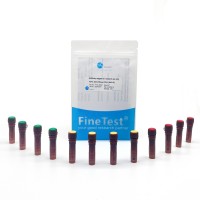Osteoclasts are cells specialized to resorb bone (
1 ,
2 ). They originate from hematopoietic progenitors (
3 ,
4 ), which are widely distributed throughout the body. Osteoclast progenitors differentiate into cells that are positive for calcitonin receptor and tartrate-resistant acid phosphatase (TRAP), which are specific markers for this lineage, and then they fuse with each other and form fully functional multinucleated large cells (
1 ,
2 ) (Fig. 1 ). TRAP-positive osteoclasts are found tightly attached to bone matrix (
1 ,
2 ). Two cytokines, macrophage colony-stimulating factor (M-CSF) and receptor activator of NF-κB (RANK) ligand (RANKL; also known as OPGL, ODF, and TRANCE), are known to be responsible for this differentiation (
5 –
7 ). In this chapter, we describe the procedure for the induction of differentiation into the osteoclast lineage from murine embryonic stem (ES) cells (
8 ). We utilize co-culture systems with stromal cell lines, that is, bone marrow-derived ST2 cells (
9 ) or newborn calvaria-derived M-CSF-deficient OP9 cells (
10 ). M-CSF is produced constitutively by ST2, and the expression of RANKL is induced on ST2 by 1,25-dihydroxyvitamin D
3 [1,25(OH)
2 D
3 ] and dexamethasone (Dex) (
6 ).
Fig. 1. Scheme describing the development of osteoclast lineage. The essential molecules expressed in this lineage are indicated at the stage where maturation is arrested by the loss of function. The cells positive for TRAP are shaded.






